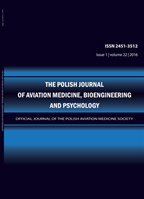2013, Volume 19, Issue 4
Hypothalamic-Pituitary Sarcoidosis - Clinical and Aviation-Medical Decision Making Aspects
Łukasz Olendrzyński1, Katarzyna Piątek2
-------------------------------------------------------------------------------------------------
1Clinical Center, Military Institute of Aviation Medicine
2Department of Endocrinology, Metabolism and Internal Medicine, Poznan University of Medical Sciences
Autor korenspondencyjny: Łukasz Olendrzyński; Clinical Center, Military Institute of Aviation Medicine; email: lolendrz[at]wiml.waw.pl
Full text
Streszczenie
Sarcoidosis is a multisystem disease of unknown etiology. It is characterized by the presence of noncaseating granulomas in the affected organs. Central nervous system involvement is observed in approximately 5% of patients. Granulomatous infiltration has a special predilection for the hypothalamus, pituitary gland, and, less commonly, pituitary stalk. Clinical symptoms include abnormal secretion of hormones of the anterior and posterior pituitary, including complete hypopituitarism. Neurosarcoidosis can mimic other, more common lesions. The mainstay of treatment is the use of steroids and supplements of the missing hormones. Despite the fact that hypothalamic-pituitary sarcoidosis is relatively rare, it should be taken into account in differential diagnosis during medical procedures in pilots and other aviation personnel. The variety of clinical symptoms that may occur in the course of neurosarcoidosis may lead to incorrect clinical diagnoses as well as significantly contribute to the reduction of flight safety.
Słowa kluczowe
sarcoidosis, sarcoidosis, hypothalamus, hypothalamus, pituitary, pituitary, hormones, hormones, glucocorticoids, glucocorticoids
